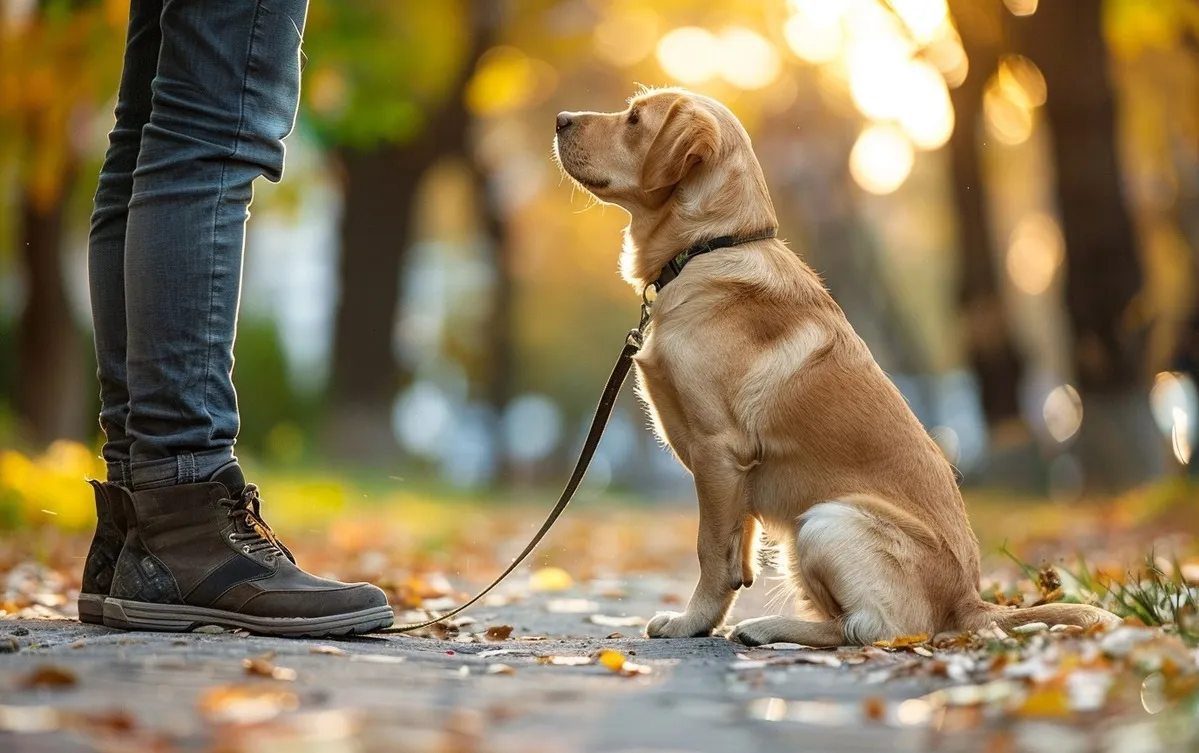Picture this: you’re strolling down a bustling street with your furry best friend, when suddenly, a squirrel darts across your path. Your dog, being the adorable goofball they are, lunges after the critter, nearly dragging you into oncoming traffic. Yikes! That’s where the magical “stay” command comes in.
The “stay” command is like teaching your dog to hit pause on their zoomies, ensuring they stay put until you give the green light. It’s not just about preventing embarrassing squirrel chases; it’s about keeping your pup safe and sound in all sorts of situations. Whether it’s dodging a skateboarder, waiting patiently at the vet’s office, or staying out of the kitchen while you’re whipping up dinner, a rock-solid “stay” can be a lifesaver.
Plus, let’s be honest, a dog who can hold a pose for a photo op is pretty darn cool.
But what exactly is the “stay” command?
In a nutshell, “stay” means your dog remains in a specific position (sitting, standing, or lying down) until you release them with another cue. Think of it as the doggy version of “freeze tag.” But why is it so important?
- Safety first: “Stay” prevents your dog from bolting into danger, whether it’s traffic, a busy road, or a potentially hazardous object.
- Better manners: A well-trained “stay” can make outings more enjoyable and less stressful for everyone involved.
- Bonding time: Training strengthens your bond with your dog, building trust and communication.
Decoding your dog’s learning style
Just like us humans, dogs have different learning styles. Some are visual learners who pick up cues from hand signals, while others are auditory learners who respond best to verbal commands. And then there are the kinesthetic learners, the “touchy-feely” types who learn through physical guidance.
Understanding your dog’s preferred learning style can make the training process smoother and more successful. If your pup is a visual learner, use clear hand signals along with verbal cues. For auditory learners, focus on consistent verbal commands and enthusiastic praise. Kinesthetic learners might benefit from gentle physical guidance as they learn the “stay” position.
No matter their learning style, positive reinforcement is key. Reward your pup with treats, praise, and belly rubs when they get it right. Remember, patience and consistency are the secret ingredients to a well-trained dog!
Prepping Your Pup for Success
Before you dive into teaching the “stay” command, let’s make sure your furry friend is set up for success. It’s like getting all your ingredients prepped before baking a delicious dog treat – it makes the whole process smoother and more enjoyable!
First and foremost, make sure your pup has mastered some basic obedience commands like “sit” and “down.” Think of these as building blocks for more advanced tricks. If your dog can’t hold a “sit” for a few seconds, they’ll likely struggle with the “stay” command.
Also, ensure your dog is feeling their best. A well-rested, well-fed, and recently potty-trained pup is a happy and attentive learner. Avoid training sessions right after mealtime, as a full tummy can lead to distractions and discomfort.
And here’s a little secret from seasoned dog trainers: establishing yourself as the “pack leader” can make a world of difference. Dogs are naturally inclined to follow a leader, so if your pup sees you as the top dog, they’ll be more eager to please and follow your commands.
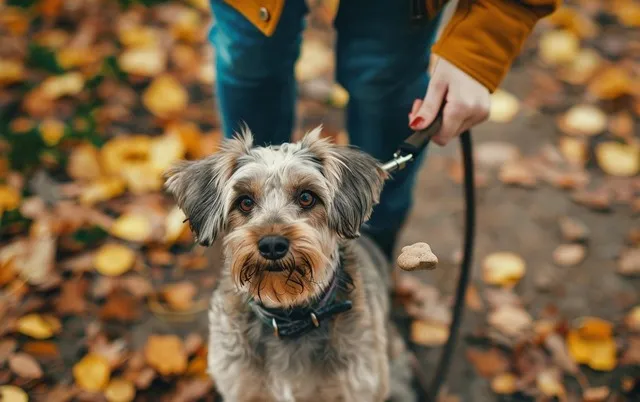
Gathering Your Training Toolkit
Now that your pup is primed and ready, let’s gather your training essentials. It’s like packing a backpack for a fun-filled adventure with your furry companion!
- High-value treats: These are the ultimate motivators for your dog. Think yummy, irresistible treats that they’ll go bananas for. Small, bite-sized treats are ideal for training sessions, as they’re easy to eat quickly and won’t fill your pup up too fast.
- Leash: A comfortable leash is essential for guiding and controlling your dog during training. Choose a length that’s appropriate for the size of your dog and the environment you’re training in.
- Quiet training location: Find a calm, distraction-free space where your dog can focus on you and the task at hand. This could be a fenced-in backyard, an empty room in your house, or a quiet park.
- Clicker (optional): Some trainers find clickers helpful for marking the exact moment their dog performs the desired behavior. If you decide to use a clicker, make sure to introduce it to your dog gradually and associate it with positive reinforcement.
- Treat pouch: A handy treat pouch clipped to your belt or waistband can make rewarding your dog a breeze. It keeps your hands free and allows you to quickly deliver treats without fumbling around in your pockets.
- Long line: If you’re training in a large open space, a long line can give your dog more freedom of movement while still allowing you to maintain control.
Setting the Stage for Success
Creating a positive and motivating training environment is crucial for successful learning. Think of it as setting the mood for a fun and rewarding experience for both you and your dog.
Choose a quiet location with minimal distractions. If you’re training indoors, turn off the TV and radio, and ask other family members to give you some space. If you’re training outdoors, pick a time of day when there aren’t many people or dogs around.
You can also enhance the training environment with calming music or dog-safe essential oils. Certain scents like lavender and chamomile are known to have a calming effect on dogs, reducing anxiety and promoting relaxation.
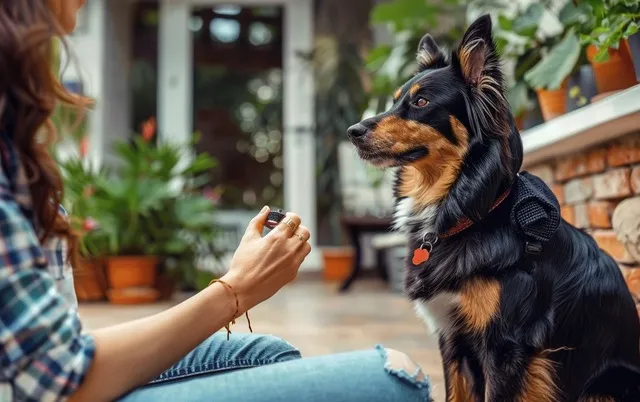
Step-by-Step Guide to Training Your Dog to Stay
Now, let’s dive into the nitty-gritty of teaching your pup the art of staying put. It’s like choreographing a dance routine, but instead of fancy footwork, we’re aiming for a perfectly still pooch!
Stage 1: Introducing the “Stay” Cue
In this initial stage, we’ll introduce your dog to the “stay” command and its corresponding hand signal. Choose a verbal cue that’s clear and distinct, like “stay,” “wait,” or “hold.” Pair this verbal cue with a hand signal, such as holding your palm open and facing your dog.
Here’s a breakdown of how to get started:
- Ask your dog to sit: Start with your dog in a sitting position. This is usually the easiest position for dogs to hold initially.
- Give the cue: With your dog sitting, say your chosen cue word in a firm but gentle voice while simultaneously holding up your open palm.
- Take a small step back: Slowly take one small step backward while maintaining eye contact with your dog.
- Reward immediately: If your dog remains seated, even for a split second, shower them with praise and a tasty treat! Timing is crucial here. You want to reward them the instant they exhibit the desired behavior.
- Repeat and gradually increase: Repeat this process, gradually increasing the number of steps you take backward and the duration your dog holds the “stay.” Start with just a few seconds and slowly work your way up to longer intervals.
- Tip: Remember to keep your body language relaxed and encouraging. Avoid leaning forward or making sudden movements, as this can confuse or startle your dog.
Stage 2: Leveling Up the Challenge
Once your dog has mastered the basic “stay” command, it’s time to crank up the challenge! We’ll add some distance, duration, and distractions to the mix, turning your pup into a “stay” champion.
- Increase the duration: Gradually extend the time your dog is required to stay in position before receiving a reward. Start with a few seconds, then progress to 10 seconds, 20 seconds, and so on. Be patient and consistent, and don’t rush the process.
- Increase the distance: Once your dog can reliably stay for a set duration, start increasing the distance you move away from them while they’re holding the “stay.” Begin with a few small steps and gradually increase the distance as they become more comfortable.
- Proofing with distractions: Now comes the fun part! Start introducing distractions to test your dog’s ability to stay put in real-world scenarios. Begin with mild distractions like having someone walk by or tossing a toy nearby. As your dog progresses, gradually increase the intensity of the distractions, such as playing loud noises or having other dogs present.
Tip: If your dog breaks the “stay” at any point, calmly return them to the starting position and begin again. Don’t scold or punish them, as this can create negative associations with training.
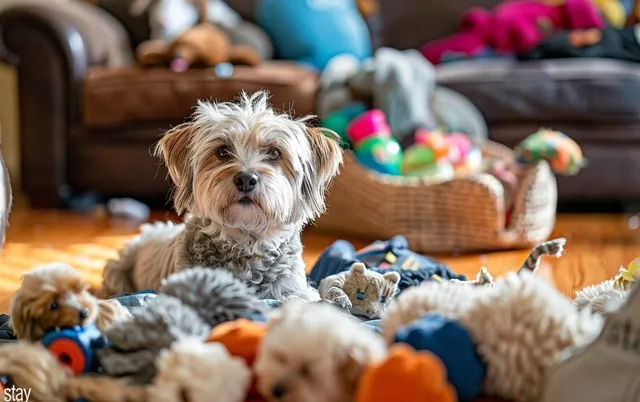
Stage 3: Generalizing the “Stay” Command
Think of this stage as taking your dog’s “stay” skills on the road. We want them to be able to stay put in various environments, positions, and with different people.
- Practice in different locations: Take your training sessions outdoors to parks, sidewalks, and other dog-friendly areas. This helps your dog understand that the “stay” command applies in different environments, not just at home.
- Vary the positions: Ask your dog to stay in different positions, such as sitting, standing, or lying down. This ensures they can maintain the “stay” regardless of their posture.
- Involve other people: Ask friends or family members to practice the “stay” command with your dog. This helps them generalize the behavior and learn to respond to different people giving the cue.
- Practice during walks: Incorporate the “stay” command into your daily walks. Ask your dog to stay before crossing the street, greeting other dogs, or entering a store.
Remember, consistency is key! The more you practice the “stay” command in different situations, the more reliable it will become.
Troubleshooting Common “Stay” Training Challenges
Let’s be real – not every training session is going to be a walk in the park (pun intended!). Even the most eager-to-please pups can hit a few bumps in the road on their journey to mastering the “stay” command. But don’t fret! Here are some common hiccups you might encounter and how to overcome them:
My Dog Simply Won’t Stay!
Patience, my friend, patience! Remember, Rome wasn’t built in a day, and neither is a perfectly trained dog. If your dog struggles with staying put, go back to basics.
- Start with shorter durations: Don’t expect your pup to hold a “stay” for minutes on end right away. Begin with just a few seconds and gradually increase the time as they become more comfortable.
- Reduce distractions: If your dog is easily distracted, start training in a quiet environment with minimal stimuli. As they progress, gradually introduce distractions, like toys or other people, in controlled settings.
- Up the ante on treats: If your usual treats aren’t cutting it, try using higher-value rewards, like small pieces of cooked chicken or cheese. Reserve these extra-special treats for training sessions only to maximize their effectiveness.
My Dog Gets Overexcited and Breaks the Stay
We’ve all been there – you’re so close to nailing that perfect “stay,” but your pup’s excitement gets the better of them. Don’t worry, here are a few tricks to calm their enthusiasm:
- Redirect their attention: If your dog breaks the “stay” due to excitement, calmly redirect their attention to another command or activity. For example, ask them to sit or fetch a toy, then try the “stay” again once they’ve calmed down.
- Practice calming techniques: Teach your dog relaxation techniques, like deep breathing or lying down in a calm position. Incorporate these techniques into your training sessions to help them manage their excitement.
- Adjust your training environment: If your dog consistently gets overstimulated during training, try switching to a quieter location or a different time of day.
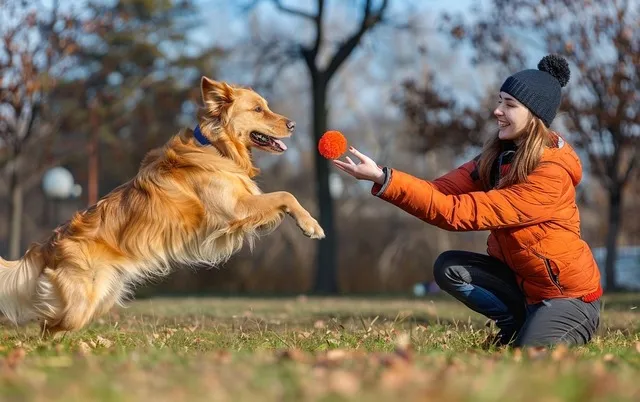
Tip: Remember, every dog is an individual. Some pups learn quickly, while others need more time and patience. Don’t compare your dog’s progress to others, and celebrate every small victory along the way.
Advanced S tay Training: Taking It to the Next Level
Once your dog has mastered the basic “stay” command in various situations, you can explore some advanced training techniques to further refine their skills.
“Distance Stay” with a Target
This technique involves teaching your dog to stay on a designated target (like a mat or a specific spot on the ground) while you move away from them. It’s a great way to practice staying for longer durations and at greater distances.
To teach this, start by placing the target object a short distance away from your dog. Ask them to “stay” on the target, then gradually increase the distance between you and the target as they become more reliable.
“Stay” While Out of Sight
This advanced technique involves training your dog to stay in position even when you’re not visible to them. It’s a great way to test their impulse control and strengthen their trust in you.
Start by briefly hiding behind a door or object while your dog is in a stay position. If they remain in place, reward them with praise and treats when you reappear. Gradually increase the time and distance of your hiding spot as your dog becomes more comfortable.
Remember, these advanced techniques require patience, consistency, and positive reinforcement. Don’t rush the process, and celebrate each milestone along the way!
I hope these troubleshooting tips and advanced training ideas help you and your pup become “stay” superstars. Keep up the great work, and most importantly, have fun with it!
Conclusion
Congratulations, you’re well on your way to becoming a “stay” training pro! By following this guide, you’ve unlocked a powerful tool for managing your dog’s behavior, keeping them safe, and strengthening your bond. Remember, the “stay” command isn’t just about having a well-behaved dog; it’s about empowering your furry friend with the skills they need to navigate the world confidently and safely.
With patience, consistency, and a whole lot of positive reinforcement, your dog will soon be wowing you with their impeccable “stay” skills. Whether it’s waiting patiently for their dinner, posing for that perfect Instagram shot, or staying safely by your side on a busy street, the “stay” command opens up a world of possibilities for both of you.
So, what are you waiting for? Grab those treats, find a quiet spot, and start training! And don’t forget to share your training triumphs and funny stories in the comments below. We’d love to hear about your “stay” adventures!
FAQs – How to teach a dog to stay
Why does my dog keep breaking their stay when I increase the distance or add distractions?
This question addresses a common roadblock in stay training. You can elaborate on potential causes and offer solutions.
Can I teach an older dog the “stay” command, or is it only for puppies? (Popular & Relevant)
This question tackles a common misconception. You can reassure readers that dogs of any age can learn “stay” with patience and positive reinforcement, highlighting success stories with older dogs.
My dog knows “stay” in a quiet environment, but struggles in public places. How do I generalize the skill?
This addresses the real-world application of the command. You can offer strategies for proofing the “stay” command in different environments with gradually increasing distractions.
How do I prevent my dog from getting up during a “stay” when I release them with a verbal cue?
This question delves into a nuanced aspect of the release cue. You can explain how to clearly differentiate the release cue from other commands and offer tips on timing and consistency.
What are some creative ways to practice the “stay” command beyond the basic training steps?
This question encourages creativity and fun in training. You can suggest incorporating “stay” into games, mealtime routines, or even agility exercises to keep your dog engaged.
Is it ever okay to use negative reinforcement or punishment during “stay” training?
This question addresses a controversial topic. You can strongly emphasize the effectiveness of positive reinforcement methods and explain why punishment can be counterproductive and harmful to the dog’s well-being.
How can I use the “stay” command to help my dog with specific behavioral issues like jumping or door-dashing?
This question showcases the versatility of the “stay” command. You can explain how it can be a valuable tool for managing various behavioral problems by teaching impulse control and alternative behaviors.

My job is to make sure every fact is right and every article is a joy to read. I’m kind of like a dog trainer for information – I make it behave!

